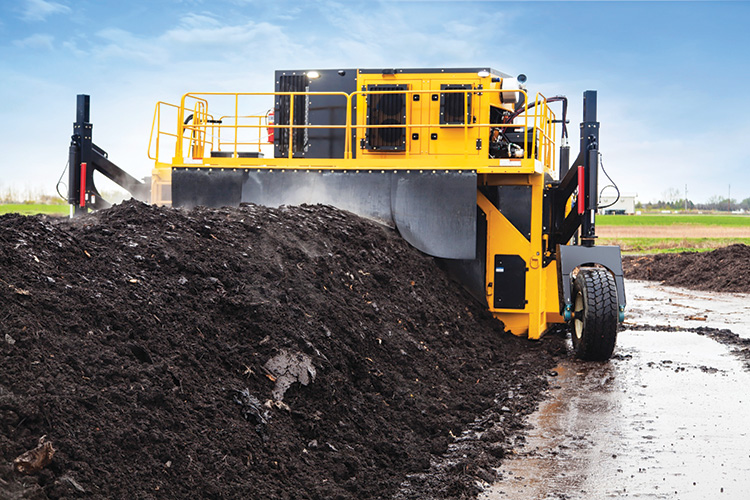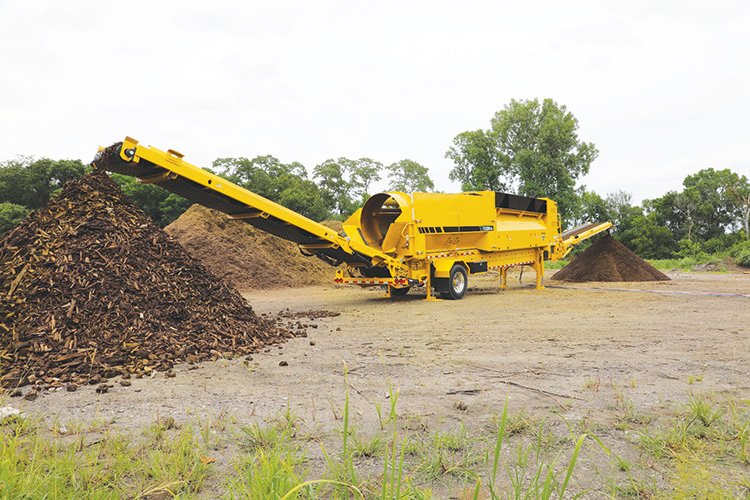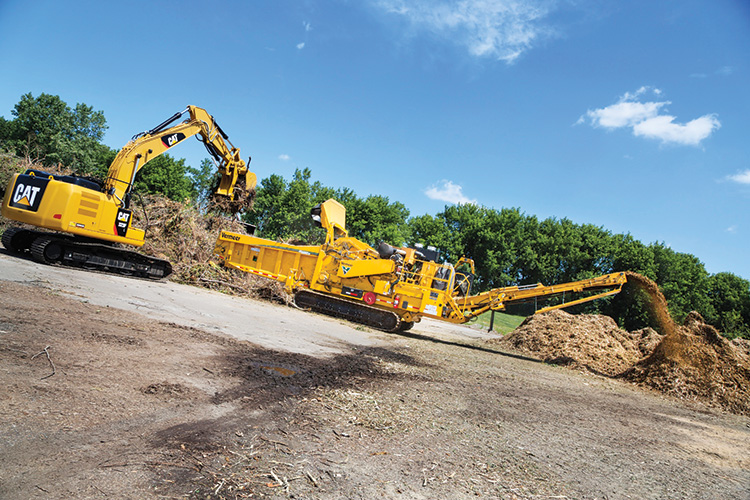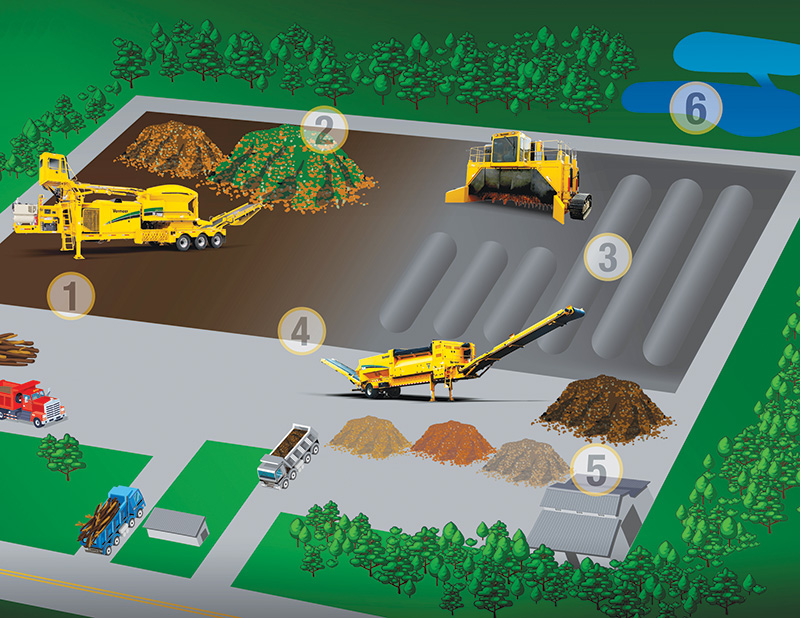Optimizing fixed operating costs and producing high-quality mulch starts with the basics. Setting up your facility to help minimize movement and deliver optimal compost maturing conditions can help you develop and grow a successful composting business.
By Ted Dirkx
Whether just starting in the composting industry or stepping up your efforts, managing fixed operational costs and producing quality end products people want to buy is critical to success. Both of those objectives can be achieved by managing how material flows through a composting yard.

The layout of a compost facility determines how efficiently material is handled and can significantly impact the quality of the end products produced. A good layout minimizes material handling and helps control outside factors, like moisture, that can impact maturing and cause odors. While the overview of how a compost facility is constructed can seem pretty basic, it is the little details that make the difference between average and great producers. To get a better understanding of the details that matter, here is a tour of an efficient composting facility.
First Stop: Drop-Off Area
How and where incoming organic waste is accepted matters. Since composting facilities typically include tip fees, their first thought is how they can make it more convenient for people to dump and leave. So, they put their drop-off area just beyond the weigh station, and if they are selling compost and/or mulch, they also want to have it readily available near the front of the facility. Having both incoming material and finished material upfront requires a lot of movement, and extra time spent moving material can have a significant impact on fixed operating expenses, reducing profit margins.
The more efficient place to accept incoming material is closer to the grinding area, so as it is processed, it can gradually move toward the front and be ready for retail. Controlling the flow from where the material is received can significantly reduce the number of times it is moved with loaders, helping to save on equipment costs, fuel, and labor. The other advantage of having the drop-off area away from the front of the facility is that it can reduce the possibility of incoming material accidentally getting mixed in with finished material waiting to be sold.


Second Stop: Incoming Material and Grinding Area
Not the same place as the drop-off area, but right alongside it is stacked raw material that will need to be run through a grinder. For the safety of customers, only trained employees should have access to this area of the operation.
What is important in this stage is material flow and efficient handling. Grinding is one of the highest cost functions of any operation, so it is important to fully use the grinder throughput potential. Materials should be able to be pushed from the drop-off area to the grinder, and the discharge should be pointed in the direction of the composting area.
Third Stop: Composting Area
In the composting area, look at things from the ground up, starting with the area’s base and at how the area drains stormwater runoff. While a dirt pad may be the most economical option, it is not going to be the most efficient or create a higher-quality compost. When dealing with wet material, like food waste, mulch, and rain, dirt pads can quickly get sloppy and potentially give off an odor. Concrete or asphalt pads often offer the best surface for producing quality finished composts.
The composting area needs to have a slope so there are places for water to go after experiencing heavy rain. To keep water from becoming trapped between compost rows, windrows should run parallel to the slope of the pad. The spacing of windrows should be kept to a minimum to help maximize the usage of the space. It is also good to use a windrow management system to track the pile lifecycle, including temperatures, to help determine the optimum time for turning material.
Fourth Stop: Screening and Finishing Area
Once the compost has matured, it is time for screening. This area should be positioned between the composting area and retail space to help minimize the material handling involved.
Trommel screens should be positioned so overs are coming off the conveyor near the composting side of the yard and fines are near the retail space. Simple little things like this can help reduce cross contamination of material, which will help result in a higher quality end product.

Images courtesy of Vermeer.
Fifth Stop: Retail Area
Once screening is complete, it is time to retail it. The setup and layout of this space will depend on your customer base. If you are selling in bulk, piles are okay. If you are bagging products, be sure your bulk material is positioned as close as possible to help minimize cycle times. Barriers should be put in place to minimize contaminants, like plastic and paper, from blowing into the retail area. Drainage and coverage should also be considered to keep materials dry and to maintain good quality.
Sixth Stop: Drainage Pond and Perimeter
Part of being a quality compost producer is being a good steward of the land. Constructing a series of drainage ponds on the low side of your property near the composting rows and establishing a barrier of trees or fencing to catch light plastic contaminates can be a good idea and are often required by state and local officials.
Drainage ponds are used to catch runoff and clean it, which is why it is important to have more than just one. The first pond collects runoff while each additional pond helps slow flow and give sediments a chance to separate. These ponds are also a good resource when the compost’s moisture levels are low. Running a pump and sprinkler is a cost-effective way to bring moisture content back to optimal levels. Fencing is almost always required, but trees can offer an additional barrier of protection.
Growing a Successful Composting Business
Optimizing fixed operating costs and producing high-quality mulch starts with the basics. Setting up your facility to help minimize movement and deliver optimal compost maturing conditions can help you develop and grow a successful composting business.
However, it does not end here. As your operation grows and evolves, the site layout and flow of material needs to be questioned and changes will need to happen. Keeping this spirit of continuous improvement alive within your operation will ultimately guide you to a more efficient compost layout. | WA
Ted Dirkx is the Sales Manager for Environmental Equipment at Vermeer. After studying composting and graduating with a degree in Environmental Studies from Central College he joined equipment manufacturer Vermeer Corporation in Pella, IA. For the past 11 years, he has been traveling about 25 weeks a year, roaming North America and beyond, helping organizations set up compost facilities, manufacture mulch, clear land, and produce biofuels. As he interacts with operations, he is a curious learner of all things that make their operations successful. He has presented at the Compost Council of Canada Conference, Canadian Wood Waste Recycling Association, Waste Expo, and USCC Conference on topics related to operational efficiency and maintenance. Dirkx can be reached at [email protected].
Vermeer Corporation reserves the right to make changes in product engineering, design, and specifications; add improvements; or discontinue manufacturing or distribution at any time without notice or obligation. Equipment shown is for illustrative purposes only and may display optional accessories or components specific to their global region. Please contact your local Vermeer dealer for more information on machine specifications.
Vermeer and the Vermeer logo are trademarks of Vermeer Manufacturing Company in the U.S. and/or other countries.
© 2022 Vermeer Corporation. All Rights Reserved.
